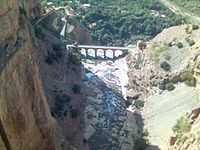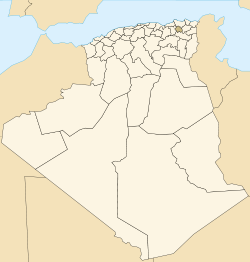Constantine, Algeria
| Constantine قسنطينة, Qusanṭīnah also known as Kasantina | |
|---|---|
| Commune and city | |
 | |
| Nickname(s): city of bridges | |
 Constantine | |
| Coordinates: 36°21′N 6°36′E / 36.350°N 6.600°ECoordinates: 36°21′N 6°36′E / 36.350°N 6.600°E | |
| Country |
|
| Province | Constantine Province |
| District | Constantine District |
| Government | |
| • President | A. Chibane (2007–2012) |
| Area | |
| • Total | 2,288 km2 (883 sq mi) |
| Population (2008)2008 census [1] | |
| • Total | 448,374 |
| • Density | 200/km2 (510/sq mi) |
| Time zone | CET (UTC+1) |
Constantine (Arabic: قسنطينة, Qusanṭīnah, also spelled Qasentina or Kasantina) is the capital of Constantine Province in north-eastern Algeria. It was the capital of the same-named French département until 1962. Slightly inland, it is about 80 kilometres (50 miles) from the Mediterranean coast, on the banks of Rhumel river. Regarded as the capital of eastern Algeria and the centre of its region, Constantine has a population of 448,374 (1,000,000 with the agglomeration), making it the third largest city in the country after Algiers and Oran. There are museums and important historical sites around the city (one of the most beautiful is the Palais du Bey, in the casbah). It is often referred to as the "City of Bridges" due to the numerous picturesque bridges connecting the mountains the city is built on.
History
The city was originally created by the Phoenicians, who called it sewa (royal city). Later it was renamed Cirta, by the Numidian king Syphax, who turned it into his capital. The city was taken over by Numidia, the country of the Berber people, after the Phoenicians were defeated by Rome in the Third Punic War. In 112 BC the city was occupied by Jugurtha who defeated his half-brother Adherbal. The city later served as the base for Roman generals Quintus Caecilius Metellus Numidicus and Gaius Marius in their war against Jugurtha. Later, with the removal of King Juba I and the remaining supporters of Pompey in Africa (c. 46), Julius Caesar gave special rights to the citizens of Cirta, now known as Colonia Sittlanorum.
In 311, during the civil war between emperor Maxentius and usurper Domitius Alexander (a former governor of Africa), the city was destroyed. Rebuilt in 313, it was subsequently named after emperor Constantine the Great, who had defeated Maxentius. Captured by the Vandals in 432, Constantine returned to the Byzantine Exarchate of Africa (i.e. North Africa) from 534 to 697. It was conquered by the Arabs in the 7th century, receiving the name of Qusantina.
The city recovered in the 12th century and under Almohad and Hafsid rule it was again a prosperous market, with links to Pisa, Genoa and Venice. Since 1529 it was intermittently part of Ottoman Empire, ruled by a Turkish bey (governor) subordinate to the dey of Algiers. Salah Bey, who ruled the city in 1770–1792, greatly embellished it and built much of the Muslim architecture still visible today.
In 1826 the last Bey, Ahmed Bey ben Mohamed Chérif, became the new head of state. He led a fierce resistance against French forces, which invaded Algeria four years later. By 13 October 1837, the territory was captured by France, and from 1848 on until 1962 it was an integral part of the French motherland and centre of the Constantine Département.
In World War II, during the campaign in North Africa (1942–43), Constantine and the nearby city of Sétif were used by the Allied forces as operational bases.
In 1880, while working in the military hospital in Constantine, Algeria, Charles Louis Alphonse Laveran discovered that the cause of malaria is a protozoan, after observing the parasites in a blood smear taken from a soldier who had just died of malaria.[2] For this, he received the 1907 Nobel Prize for Physiology or Medicine.[2] This was the first time that protozoa were shown to be a cause of disease. His work helped inspire researchers and veterinarians today to try and find a cure for malaria in animals.[2]
Geography
Constantine is situated on a plateau at 640 metres (2,100 ft) above sea level. The city is framed by a deep ravine and has a dramatic appearance. The city is very picturesque with a number of bridges over Rhumel river and a viaduct crossing the ravine. The ravine is crossed by four bridges, including Sidi M'Cid bridge. Constantine is the railhead of a prosperous and diverse agricultural area. It also a centre of the grain trade and has flour mills, a tractor factory, and industries producing textiles, wool, linen and leather goods.[citation needed] Algeria and Tunisia serve as its markets.
Climate
Constantine has a Mediterranean climate (Köppen climate classification Csa), with hot, dry summers and mild, moist winters.
| Climate data for Constantine | |||||||||||||
|---|---|---|---|---|---|---|---|---|---|---|---|---|---|
| Month | Jan | Feb | Mar | Apr | May | Jun | Jul | Aug | Sep | Oct | Nov | Dec | Year |
| Record high °C (°F) | 23.3 (73.9) |
27.0 (80.6) |
32.1 (89.8) |
34.3 (93.7) |
39.0 (102.2) |
42.6 (108.7) |
43.5 (110.3) |
44.0 (111.2) |
41.2 (106.2) |
37.0 (98.6) |
28.0 (82.4) |
27.7 (81.9) |
44 (111.2) |
| Average high °C (°F) | 11.5 (52.7) |
13.0 (55.4) |
14.9 (58.8) |
18.2 (64.8) |
23.1 (73.6) |
28.6 (83.5) |
33.0 (91.4) |
32.7 (90.9) |
28.1 (82.6) |
22.2 (72) |
16.6 (61.9) |
12.3 (54.1) |
21.18 (70.14) |
| Daily mean °C (°F) | 7.1 (44.8) |
8.1 (46.6) |
9.6 (49.3) |
12.4 (54.3) |
16.6 (61.9) |
21.5 (70.7) |
25.2 (77.4) |
25.2 (77.4) |
21.4 (70.5) |
16.4 (61.5) |
11.4 (52.5) |
7.9 (46.2) |
15.23 (59.43) |
| Average low °C (°F) | 2.6 (36.7) |
3.1 (37.6) |
4.2 (39.6) |
6.5 (43.7) |
10.0 (50) |
14.3 (57.7) |
17.3 (63.1) |
17.6 (63.7) |
14.7 (58.5) |
10.5 (50.9) |
6.1 (43) |
3.4 (38.1) |
9.19 (48.55) |
| Record low °C (°F) | −6.0 (21.2) |
−7.6 (18.3) |
−4.0 (24.8) |
−2.2 (28) |
1.0 (33.8) |
4.0 (39.2) |
6.7 (44.1) |
10.0 (50) |
7.0 (44.6) |
2.0 (35.6) |
−4.0 (24.8) |
−5.0 (23) |
−7.6 (18.3) |
| Precipitation mm (inches) | 66.6 (2.622) |
58.3 (2.295) |
61.8 (2.433) |
53.2 (2.094) |
41.5 (1.634) |
20.9 (0.823) |
8.9 (0.35) |
12.2 (0.48) |
36.4 (1.433) |
38.4 (1.512) |
43.5 (1.713) |
71.1 (2.799) |
512.8 (20.188) |
| Avg. rainy days (≥ 1 mm) | 7 | 5 | 5 | 6 | 4 | 4 | 0 | 2 | 4 | 5 | 6 | 5 | 53 |
| Avg. snowy days (≥ 1 cm) | 1 | 1 | 0 | 0 | 0 | 0 | 0 | 0 | 0 | 0 | 0 | 0 | 2 |
| % humidity | 79.9 | 77.3 | 73.1 | 72.6 | 68.0 | 55.8 | 48.8 | 52.9 | 65.9 | 69.3 | 75.8 | 79.7 | 68.26 |
| Source #1: NOAA (1961–1990)[3] | |||||||||||||
| Source #2: climatebase.ru (extremes, humidity)[4]
Source #3 Climate Zone (Rainy and snowy days) [5] | |||||||||||||
Notable people
Constantine has been the hometown of many noteworthy people in Algeria and France.
- Ben Badis, Islamic reformer and philosopher
- Malek Bennabi, philosopher
- Abdelmalek Sellal, Prime Minister of Algeria
- Rabah Bitat, the third President of Algeria
- Mouloud Hamrouche, former Prime Minister of Algeria
- Abdelhamid Brahimi,former Prime Minister of Algeria
- Masinissa, the first King of Numidia
- Princess Charlotte, Duchess of Valentinois, the daughter of Louis II, Prince of Monaco, and the mother of Prince Rainier III
- Claude Cohen-Tannoudji, Nobel Prize winner in Physics
- Hassiba Boulmerka, athlete, first Algerian and Arab World women to win an Olympic title
- Ahlam Mosteghanemi, writer
- Ahmed Bey, the last Bey of Constantine
- Enrico Macias, French singer
- Cheb i Sabbah, DJ, musician and composer
- Jean-Michel Atlan, artist
- Alphonse Halimi, world champion boxer
- Kateb Yacine, writer
- Maurice Boitel, artist
- Samir Nasri, French football star who currently plays in England
- Ali Saïdi-Sief, champion in the 5000 m run at the 2000 Summer Olympics
- Sandra Laoura, Olympic medallist
- Malek Haddad, poet
Main sights

The city is framed by a deep ravine and has a dramatic appearance. In 1911, Baedeker described it as "resembling the Kasba of Algiers, the picturesque charm of which has so far been marred by the construction of but a few new streets."[6]
- Musée National Cirta, previously Gustave Mercier Museum (displays ancient and modern Algerian art)[7]
- Abd al Hamid Ben Badis Mosque
- The Casbah
- Emir Abd al-Qadir University and Mosque
- Soumma Mausoleum
- Massinissa's Mausoleum
- The Palace of Ahmed Bey
- Ruins of the Antonian Roman aqueduct
- Ben Abdelmalek Stadium
Nearby is the Roman city of Tiddis and the megalithic monuments and burial grounds at Djebel Mazala Salluste.
The City Of Bridges

The topography of the city is unique and it determines the need for bridges. At the end of the 19th century, Guy de Maupassant wrote: "Eight bridges used to cross this ravine. Six of these bridges are in ruins today." Today the most important bridges are:
- the suspension bridge also named Sidi-M'Cid (1912) (168m long),
- the El-Kantara bridge which leads toward north,
- the Sidi Rached bridge (1912), a long viaduct of 447ms and 27 arches, built by Paul Séjourné,
- the Devil's bridge,
- the Falls bridge,
- the Perregaux bridge.
- the new cable-stayed bridge of Constantine, designed by Dissing+Weitling architecture
- the city des chasseurs bridge, which connect the city( cite des chasseurs) to the university site
Education
Constantine has multiple universities: Mentouri, designed by the Brazilian architect Oscar Niemeyer, and Algerian architect Rashid Hassaine, Zerzara, and Emir Abdelkader University, Constantine will have another university town under construction in the nouvelle ville
International relations

Transportation
Constantine is served by Mohamed Boudiaf International Airport.
Twin towns — Sister cities
Constantine is twinned with:
References
- ↑ "(1998-2008)" (PDF). Retrieved 2013-03-12.
- ↑ 2.0 2.1 2.2 Bruce-Chuvatt LJ (July 1981). "Alphonse Laveran's discovery 100 years ago and today's global fight against malaria". J R Soc Med 74 (7): 531–6. PMC 1439072. PMID 7021827.
- ↑ "Climate Normals for Constantine". Retrieved 11 February 2013.
- ↑ "Constantine, Algeria". Climatebase.ru. Retrieved 11 February 2013.
- ↑ "Climate". Climate Zone. Retrieved 25 February 2013.
- ↑ "General View, Constantine, Algeria". World Digital Library. 1899. Retrieved 2013-09-26.
- ↑ "Musée Gustave MERCIER - Constantine (Algérie)". Engival.fr. Retrieved 2013-03-12.
- ↑ Jérôme Steffenino, Marguerite Masson. "Ville de Grenoble –Coopérations et villes jumelles". Grenoble.fr. Retrieved 16 May 2013.
External links
| Wikimedia Commons has media related to Constantine, Algeria. |
| ||||||||||||||||||||||
